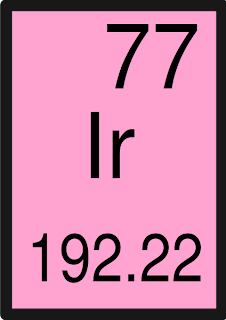Iridium is element number 77. It is a hard, sliverish transition metal, which is related
to platinum. Iridium is the second densest metal and the most corrosive
resistant.
The
name of the element comes from the Latin word "iris," which means rainbow
and who was the goddess of the rainbow. The name is appropriate because iridium
salts are known for their bright colors.
The
British chemist Smithson
Tennant discovered iridium and osmium at the same time in 1803. These
elements were found in the leftover residue of dissolving platinum ore in an
acid solution. Currently, platinum ores are still used to get iridium, and it
can be found as a bi-product of mining nickel.
Interestingly,
there is a thin layer of
iridium that spans across the entire world. Scientists believe that this is
proof of a large meteor must have hit the Earth during (or at the end of, I
guess) the Cretaceous period. Meteors and asteroids contain a higher amount of
iridium than the crust of Earth.
One
of the largest uses of iridium is as an alloy with platinum. An alloy of 90%
platinum and 10% iridium is actually the composition of the International
Prototype Metre and kilogram
mass. It is also used to make crucibles and other things that must undergo
extreme temperatures.
Iridium
is used in particle physics for the production
of antimatter, antiprotons in particular. Some other of the uses for iridium
are less impressive. Iridium alloys are used in the tips of fountain pens, and
an iridium pigment is used to paint porcelain an intense black color.

No comments:
Post a Comment